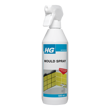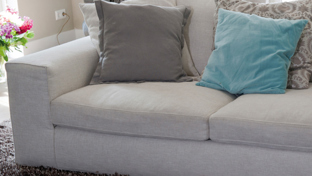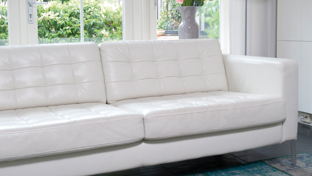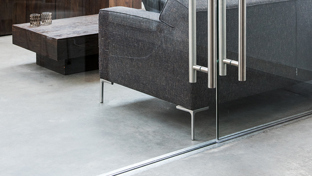Treat mould with HG products
You can have mould removed with one of the HG products. We say ‘have removed’, because the products are self-acting. You can see the results in just 30 minutes and removing mould produces a less penetrating odour than when you use vinegar or soda. The HG products that treat mould act easily and fast. Go for HG mould spray or HG mould remover foam spray. The foam spray can be trained even better on the mould patches.
 This is how you use HG mould spray or HG mould remover foam spray:
This is how you use HG mould spray or HG mould remover foam spray:
- Spray the surface with HG mould remover foam spray from a distance of 3 to 5cm.
- Leave the mould cleaning product to work for approximately 30 minutes.
- Clean the surface with water and a sponge.
- The result is a mould-free room.
Which types of mould in the house?
There are various types of moulds. Mould in a house generally involves Stachybotrys (black mould), Alternaria, Aspergillus and, Cladosporium. The colour of mould in a house differs, but usually, it is white or black mould. The spores of mould can be created by damp problems in a house, but they can also enter through a window, door, or air grill. The mould usually stays behind on walls and/or ceilings, which produces white or black mould. Dead mould also still contains substances that are harmful to human health. Removing mould as quickly as possible is important.
3 most common problems with mould in a home
Mould in the home can be formed in various rooms or surfaces. The 3 most common problems with mould in a home:
1. Mould in the bathroom
Mould in the bathroom is a common occurrence. Warm water vapour produced by showering or a bath produces condensation. This happens at the time that water vapour cannot be discharged adequately. It condensates on walls, the ceiling or windows. The surface of walls or the ceiling is rough, and that means they absorb damp easily. A mouldy wall or ceiling is a common problem in the bathroom.
 2. Mould in the bedroom
2. Mould in the bedroom
Not just in the bathroom, but mould can also occur in the bedroom. Mould develops in damp and warm rooms. If a bedroom is not ventilated properly, mould quickly forms because the damp cannot leave the room easily. In the bedroom, mould can spread with spores that float in the air. These spores end up on walls and windows, which causes mould. If you have mould on the wall, it is important to strip the wallpaper first.
3. Mould in the cellar
A cellar is also an ideal room for mould. A cellar often does not have a window, which means there is insufficient ventilation. Cardboard boxes, wood and fabrics are ideal nutrients for mould in a cellar. Mould in a cellar is bad for your health and that makes the room unusable.
Mould in the house is bad for your health. It does not make a difference whether it concerns mould in the bathroom, bedroom, cellar or any other room. Removing mould is important, but dealing with the causes of mould is just as important.
3 causes of mould
The cause of mould in the bathroom, bedroom or another place in the house is a surplus of humidity. Mould can only develop in damp conditions. Mould comes from damp issues. So apart from removing the mould, you also need to deal with the damp issue. These are the 3 most common damp issues:
1. Penetrating damp
Problems with the humidity of the facade can result in penetrating damp. Humidity of a facade that does not dry out properly can penetrate to the internal walls. The result is often damp walls, where mould can form. Penetrating damp is often a problem in houses with cracks or damaged joints. Besides removing mould from the damp internal wall, you can impregnate the facade. Impregnation prevents penetrating damp in the facade.
2. Condensation
When warm air cools down, condensation is formed. The warm air condensates on walls, the ceiling, or the windows. If the warm air is not discharged properly, the condensation has the chance to develop further into mould on the ceiling or the wall. Condensation can arise due to showering, bathing, drying clothing, or hot steam during cooking.
3. Rising damp
In older houses there is often rising damp. This is due to a damp seal that does not work properly, which means humidity from the soil rises into the walls via the foundation. It means that walls can become extremely damp in some places. The humidity from the soil contains bacteria and salts, which means you can end up with mould, and efflorescence on the walls. Efflorescence is a white deposit that is particularly visible on brick walls.
3 products that you should not use to remove mould
Various tips are shared on the internet on how to clean mould. We advise against these products in the strongest terms because they do not work on mould or actually only increase the risks:
1. Do not remove mould with vinegar
Cleaning mould with vinegar is a frequently recommended method. We advise against it because vinegar, despite being acidic, does not work on mould.
2. Never use baking soda to remove mould
Using baking soda to remove mould is still a popular recommendation. But...don't do it. Baking soda has no impact whatsoever on mould.
3. Do not remove mould with bleach
Removing mould with bleach is not a good idea either. As bleach often contains chlorine, it can remove mould. However, as it has no official approval, its impact on mould has never been tested. We always recommend you use a product with official approval.
Frequently Asked Questions about mould removal
How to get rid of mould?
It is best to remove mould with a product that has been tested for effectiveness against mould. These are products with official approval, such as HG mould cleaner or HG mould cleaner foam spray.
How do you remove mould from a wall?
Spray your wall with vinegar or soda. Leave to work for an hour and then clean the surface with a sponge or a brush. Do you want to have mould removed quickly? Go for HG mould spray or HG mould remover foam spray.
How do you remove mould from the bathroom?
You can remove mould from the bathroom with soda, vinegar or one of the HG products. Go for HG mould spray or HG mould remover foam spray.


























